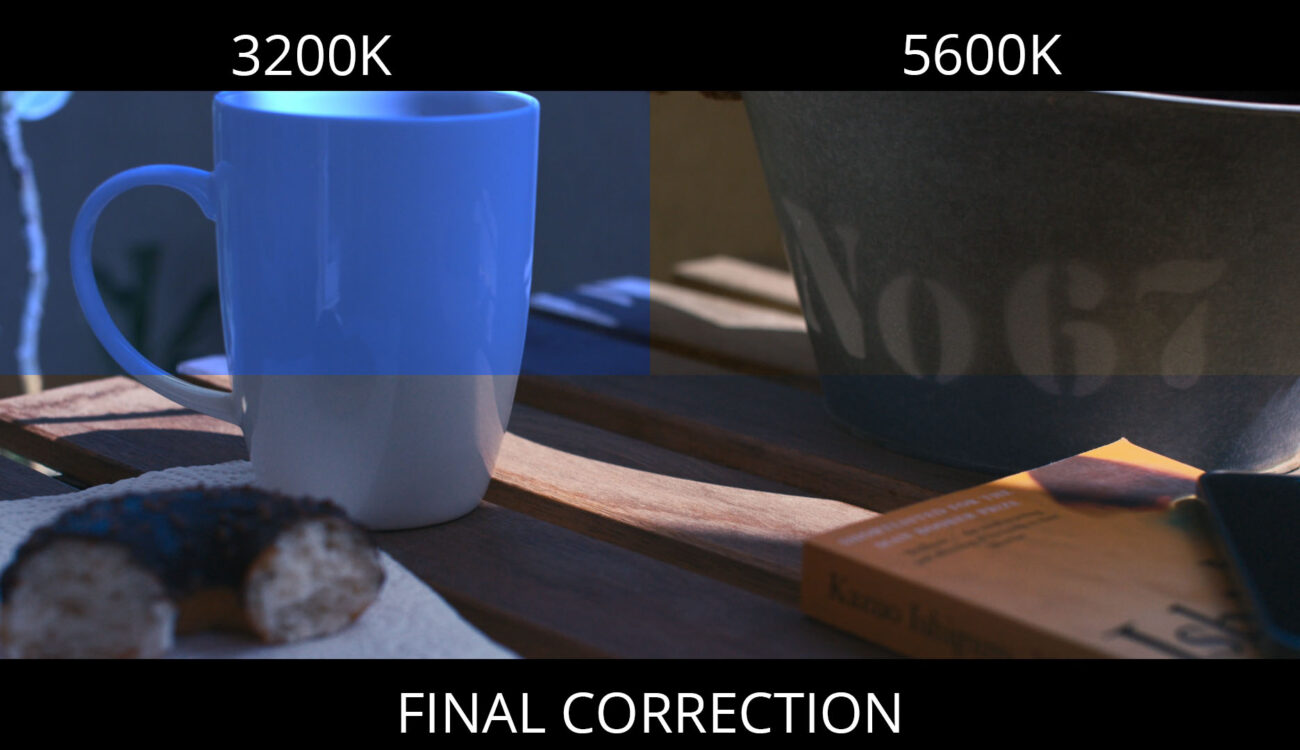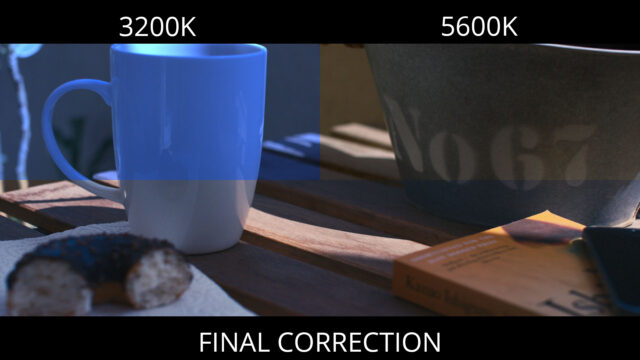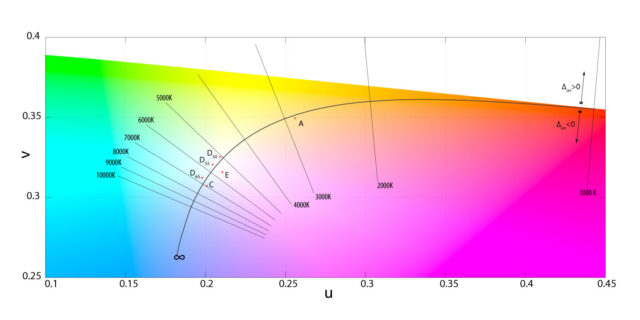
Often misunderstood, color temperature is an important concept which can have serious implications for the images which we create.
In the picture above, you can see three versions of the same image—each shot with different in-camera white balance (color temperature) settings:
- Top left: incorrectly balanced at 3200K (tungsten)
- Top right: correctly balanced at 5600K (daylight)
- Bottom: final color correction, based on the properly balanced 5600K shot
Looking at the example, it quickly becomes apparent just how important color temperature can be.
Why is Color Temperature Important?
It is vital to understand the ways in which color temperature affects our shots. Not only does it play a part in how white surfaces in our scenes are recorded, but it is also pivotal in the overall balance between every color of every surface in the scene. Usually, we want objects that appear white in reality to also appear white in our recorded images—and when white is balanced correctly, all other colors will be balanced correctly, too.
A white surface appears white because your brain tells you that it is white. However, it may actually be reflecting the blue light of an overcast day, or the deep orange of the sun just before it disappears below the horizon.
Camera White Balance
While our eyes and brain adjust continually to changing light conditions, a camera will not. You have to tell your camera what color light is illuminating your scene, and it needs to be adjusted every time the light changes. This is your “white balance” or “color temperature” setting, and if you are recording any format other than RAW, this setting permanently determines the color balance of your recorded image. It is imperative to get this right as correcting mistakes in post can be tough.
RAW
If you are recording RAW sensor data, then your in-camera white balance setting only affects the way you are monitoring your image; it will be saved as metadata but will have no effect on the recorded image data. Recording in RAW gives you full control over the color temperature in post.
Let’s start with a look at color.
The Physics of Color
Visible light is a form of electromagnetic radiation, with a frequency (wavelength) that determines its color. The frequency of light in the visible spectrum is between 390nm – 700nm (nanometers—billionths of a meter!).
A red painted surface will absorb all wavelengths of light except the color red, red light is reflected, and our eyes detect the light which is registered by our brain as red.
A white surface, however, is not selective: it reflects the full spectrum of wavelengths of any light falling on it equally.
What is White Light?
White light contains an equal mix of wavelengths (colors) of the full visible spectrum. This is why white light can be split by a prism into the different wavelengths it contains—white light is an equal mix of everything.
It’s important to understand that every light source we encounter actually does have a color, it emits an uneven mix of wavelengths, and therefore “white” in our scene is determined by the color of light illuminating our scene.
Color Temperature
According to Wikipedia – The color temperature of a light source is the temperature of an ideal black-body radiator that radiates light of comparable hue to that of the light source.
A black-body radiator is any object which fully absorbs all frequencies of light, just as a white body is any object which fully reflects all frequencies of light. Black-body radiation (according to Wikipedia) is the type of electromagnetic radiation (light) emitted by a black body (an opaque and non-reflective body) held at constant, uniform temperature. The radiation has a specific spectrum and intensity that depends only on the temperature of the body.
In other words, the hue (color or specific spectrum) of light emitted by a black body radiator is determined by its temperature.
The sun or a tungsten incandescent filament lamp are both examples of near perfect black body radiators.
The temperature of the black body radiator is measured in degrees Kelvin and therefore, the color (specific spectrum) of light emitted by a black body radiator can be determined by its temperature in degrees Kelvin.
This can—and has been—mapped onto a chromaticity diagram, forming a curve called Planckian locus.
Real-World Light Sources
The below table is from Wikipedia and is a helpful reference for knowing the color of your typical light sources.
| Temperature | Source |
|---|---|
| 1,700 K | Match flame, low-pressure sodium lamps (LPS/SOX) |
| 1,850 K | Candle flame, sunset/sunrise |
| 2,400 K | Standard Incandescent lamps |
| 2,550 K | Soft White Incandescent lamps |
| 2,700 K | “Soft White” compact fluorescent and LED lamps |
| 3,000 K | Warm White Compact fluorescent and LED lamps |
| 3,200 K | Studio lamps, photofloods, etc. |
| 3,350 K | Studio “CP” light |
| 4,100–4,150 K | Moonlight |
| 5,000 K | Horizon daylight |
| 5,000 K | Tubular fluorescent lamps or cool white/daylight compact fluorescent lamps (CFL) |
| 5,500–6,000 K | Vertical daylight, electronic flash |
| 6,200 K | Xenon short-arc lamp |
| 6,500 K | Daylight, Overcast |
| 6,500–9,500 K | LCD or CRT screen |
| 15,000–27,000 K | Clear blue poleward sky |
| These temperatures are merely characteristic; considerable variation may be present. | |
The easiest way to make sure your white balance is correct is simply to be aware of the light sources illuminating your scene. The two common standard color temperatures for film and video lighting are “Tungsten” at 3200K and “Daylight” at 5600K. Knowing those two numbers will go a long way to making sure your image is balanced for your light source within the ability to make finer correction in post.
Keeping some other values from the table above in mind will also go a long way, for instance if it’s an overcast day outside, you may want to set your camera closer to 6500K.
Planning Ahead
Mixed light sources can often cause problems, and unless you are intentionally lighting with mixed sources for creative purposes, it is well worth keeping a single color light source in mind when planning ahead. A location recce goes a long way to determining how an area is lit during the day, at night, and what practical light sources are present.
By planning ahead and identifying potentially problematic lighting conditions beforehand, you can make informed decisions about how to tackle lighting different locations and what equipment you will need.
By understanding color temperature, you will always be ready to balance your camera even in situations where you have no control over lighting at all.
Correctly setting your color temperature in-camera is easy. It’s definitely not something you want to fix in post, so always attempt to get your in-camera color temperature right and avoid the headaches that incorrectly balanced images can cause.

























